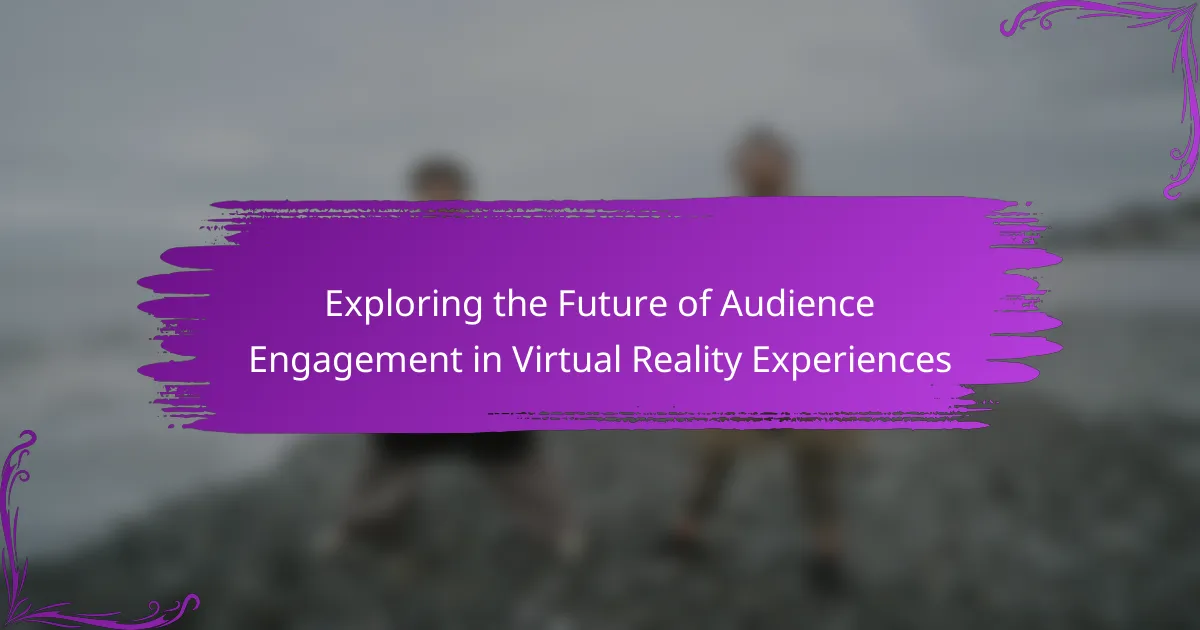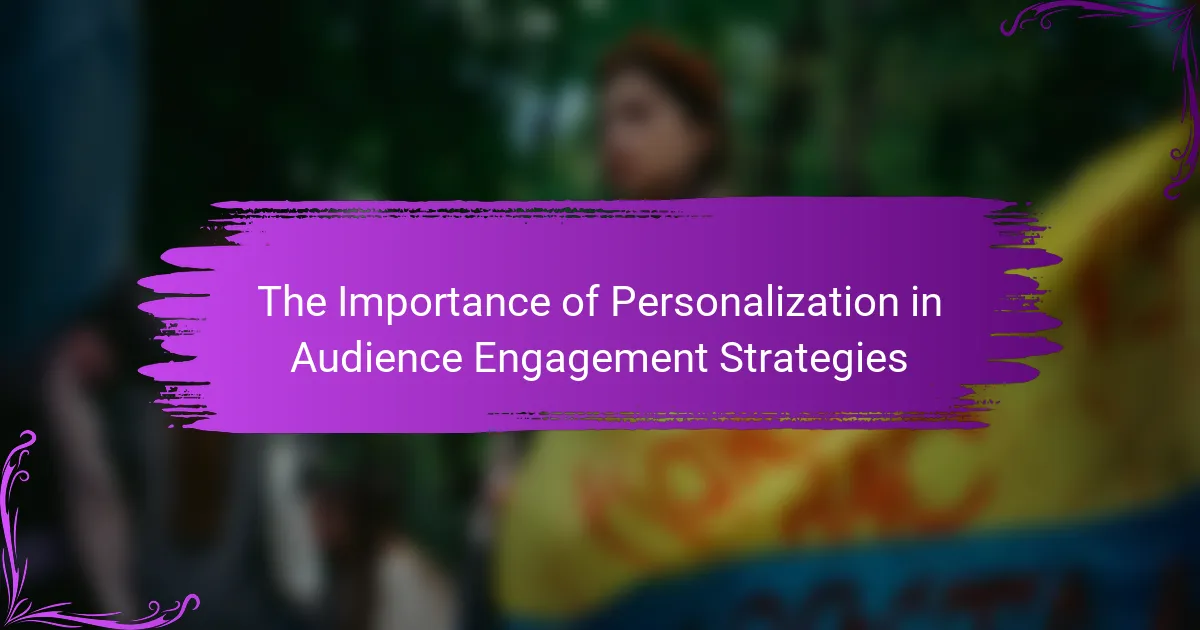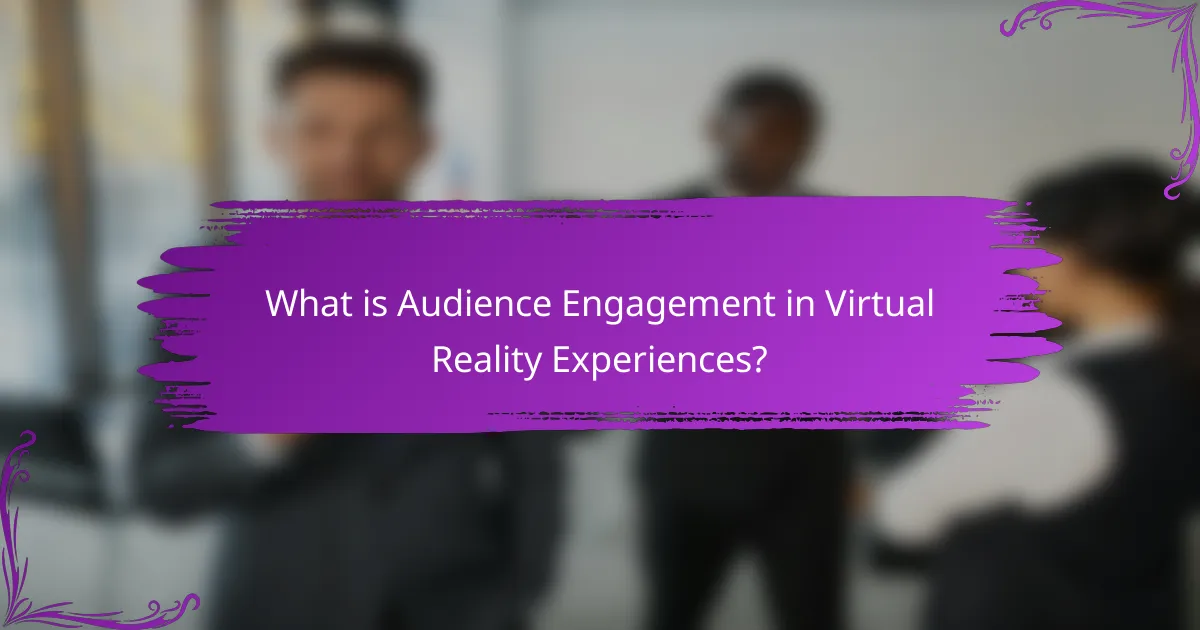
What is Audience Engagement in Virtual Reality Experiences?
Audience engagement in virtual reality experiences refers to the interaction and emotional connection between users and the VR content. This engagement is facilitated through immersive environments that stimulate the senses. Users can actively participate in scenarios, enhancing their involvement. Effective audience engagement can lead to increased retention of information and a more memorable experience. Studies show that immersive VR can boost user attention and motivation significantly. For example, a study by Slater et al. (2009) demonstrated that users in VR environments showed higher levels of presence and engagement compared to traditional media. This highlights the potential of VR to transform audience engagement strategies.
How does audience engagement differ in virtual reality compared to traditional media?
Audience engagement in virtual reality (VR) significantly differs from traditional media. VR offers immersive experiences that allow users to interact with the environment and content. This interactivity fosters a sense of presence and emotional connection that traditional media lacks. In traditional media, engagement is often passive, with limited viewer participation. Studies indicate that VR can increase retention rates by up to 70% compared to 10% in traditional settings. Additionally, VR experiences can adapt to user choices, creating personalized narratives. This adaptability enhances user investment in the experience. Overall, VR transforms audience engagement by making it active and personalized, unlike the passive consumption typical in traditional media.
What are the key elements of audience engagement in virtual reality?
Key elements of audience engagement in virtual reality include immersion, interactivity, and social presence. Immersion allows users to feel as though they are part of the virtual environment. This is achieved through high-quality visuals and sound, which enhance the realism of the experience. Interactivity enables users to influence the environment through their actions. This can involve manipulating objects or making choices that affect the narrative. Social presence refers to the feeling of being with others in the virtual space. Research indicates that these elements significantly enhance user satisfaction and retention. For instance, a study by Slater and Wilbur (1997) highlights the importance of immersion in creating a compelling VR experience.
How do immersive technologies enhance audience interaction?
Immersive technologies enhance audience interaction by creating engaging, interactive environments. These technologies, such as virtual reality (VR) and augmented reality (AR), allow users to experience content in a more dynamic way. For instance, VR can transport users to simulated worlds where they can explore and interact with the environment. This level of engagement fosters a deeper emotional connection to the content. Research shows that immersive experiences can increase retention rates by up to 70%. This is due to the active participation required from users, which enhances learning and enjoyment. Furthermore, immersive technologies facilitate real-time feedback and collaboration among participants, enriching the overall interaction.
Why is audience engagement important in virtual reality experiences?
Audience engagement is crucial in virtual reality experiences because it enhances immersion and interaction. Engaged users are more likely to retain information and connect emotionally with content. According to a study by the University of Maryland, immersive environments increase memory retention by 30% compared to traditional media. High levels of engagement also lead to longer session durations, maximizing the effectiveness of the experience. Moreover, when users actively participate, they provide valuable feedback that can improve future virtual reality applications. Therefore, fostering audience engagement is essential for creating impactful and memorable virtual reality experiences.
What impact does effective engagement have on user experience?
Effective engagement significantly enhances user experience. It fosters a sense of connection between the user and the content. Engaged users are more likely to retain information and develop a positive attitude toward the experience. According to a study by the Nielsen Norman Group, users who feel engaged are 50% more likely to return to the platform. Furthermore, effective engagement can increase user satisfaction and loyalty. This is supported by research from Adobe, which found that 38% of users will stop engaging with a website if the content is unappealing. Thus, effective engagement plays a crucial role in shaping a positive user experience.
How does audience engagement influence the success of virtual reality projects?
Audience engagement significantly influences the success of virtual reality projects. Engaged audiences are more likely to participate actively and share their experiences. This active participation can lead to increased word-of-mouth promotion. According to a study by the International Journal of Information Management, projects with higher engagement levels saw a 40% increase in user retention. Engaged users also provide valuable feedback, which can enhance future project iterations. Furthermore, immersive experiences that resonate with the audience tend to generate more positive reviews. Positive reviews, in turn, attract new users and boost project visibility. Thus, audience engagement is a critical factor for the overall success of virtual reality initiatives.
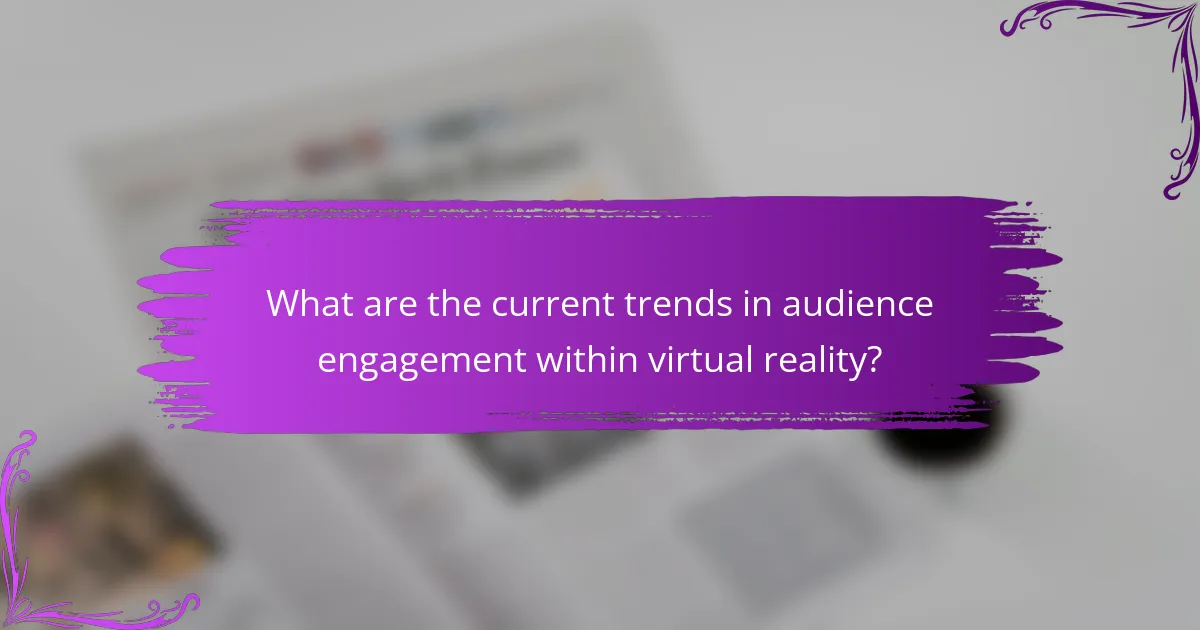
What are the current trends in audience engagement within virtual reality?
Current trends in audience engagement within virtual reality include increased interactivity and social experiences. Users now seek immersive environments that allow for real-time interaction. This shift enhances emotional connections and user retention. Another trend is the integration of gamification elements to motivate participation. Research indicates that gamified VR experiences can boost engagement by up to 50%. Additionally, personalized content tailored to user preferences is becoming more prevalent. This personalization fosters deeper connections and satisfaction. Finally, cross-platform accessibility is gaining traction. Users expect seamless experiences across devices, which broadens audience reach and engagement potential.
How are developers leveraging technology to enhance engagement?
Developers are leveraging technology to enhance engagement by creating immersive virtual reality (VR) experiences. These experiences allow users to interact with digital environments in real-time. Technology enables developers to integrate interactive elements that respond to user actions. For instance, haptic feedback devices provide tactile sensations, increasing immersion. Additionally, developers use artificial intelligence to personalize content based on user preferences. This personalization fosters a deeper emotional connection with the audience. Research shows that immersive experiences can increase user retention rates by 70%. Overall, technology enhances engagement by making virtual experiences more interactive and personalized.
What role does artificial intelligence play in audience engagement?
Artificial intelligence enhances audience engagement by personalizing experiences and predicting user preferences. AI algorithms analyze user data to tailor content specifically to individual interests. This tailored approach increases user satisfaction and retention rates. For instance, platforms like Netflix utilize AI to recommend shows based on viewing history. Additionally, AI-driven chatbots facilitate real-time interaction, providing instant responses to audience inquiries. Research indicates that personalized recommendations can boost engagement by up to 80%. Overall, AI’s ability to adapt content and interact dynamically plays a crucial role in engaging audiences effectively.
How are social interactions facilitated in virtual reality environments?
Social interactions in virtual reality environments are facilitated through immersive avatars and interactive spaces. Users create personalized avatars that represent them in the virtual world. These avatars allow for non-verbal communication through gestures and expressions. Virtual environments often include shared spaces where users can gather and interact. Voice chat features enable real-time audio communication among participants. Additionally, social cues are enhanced through spatial audio, which mimics real-life sound dynamics. Research shows that these elements significantly increase user engagement and social presence. Platforms like VRChat and AltspaceVR exemplify these interactive features, promoting community building and social interaction.
What are the challenges faced in achieving audience engagement in virtual reality?
Achieving audience engagement in virtual reality faces several challenges. One major challenge is the technological barrier, as high-quality VR experiences require advanced hardware. Many users may not have access to the necessary equipment, limiting audience reach. Another challenge is user comfort; prolonged use of VR can lead to motion sickness or discomfort, which discourages engagement. Additionally, creating compelling content that captivates audiences is complex and resource-intensive. The need for immersive storytelling adds another layer of difficulty. Furthermore, the learning curve associated with using VR technology can hinder user participation. Lastly, ensuring social interaction within VR environments is challenging, as users may feel isolated in single-user experiences. These factors collectively impact the effectiveness of audience engagement in virtual reality.
What technical limitations affect user engagement?
Technical limitations that affect user engagement include inadequate hardware performance and latency issues. In virtual reality, low frame rates can lead to motion sickness and discomfort. Insufficient graphics quality can detract from the immersive experience. Limited field of view can restrict user interaction and engagement. Device compatibility issues can hinder access for potential users. Network bandwidth limitations can result in lag and interruptions during experiences. Additionally, lack of intuitive user interfaces can reduce engagement levels. These factors collectively impact the overall effectiveness of virtual reality in engaging audiences.
How do user expectations shape engagement strategies?
User expectations significantly shape engagement strategies by guiding the design and implementation of interactive experiences. When users anticipate specific features or levels of interactivity, engagement strategies must align with these expectations to ensure satisfaction. For instance, studies show that users expect immersive environments in virtual reality. This expectation drives developers to prioritize high-quality graphics and seamless interactions. Additionally, user feedback often informs the evolution of engagement strategies. As users express their preferences, companies adapt their offerings to meet these demands. Research indicates that aligning engagement strategies with user expectations can enhance user retention and overall experience quality. In summary, understanding and responding to user expectations is crucial for effective engagement in virtual reality experiences.
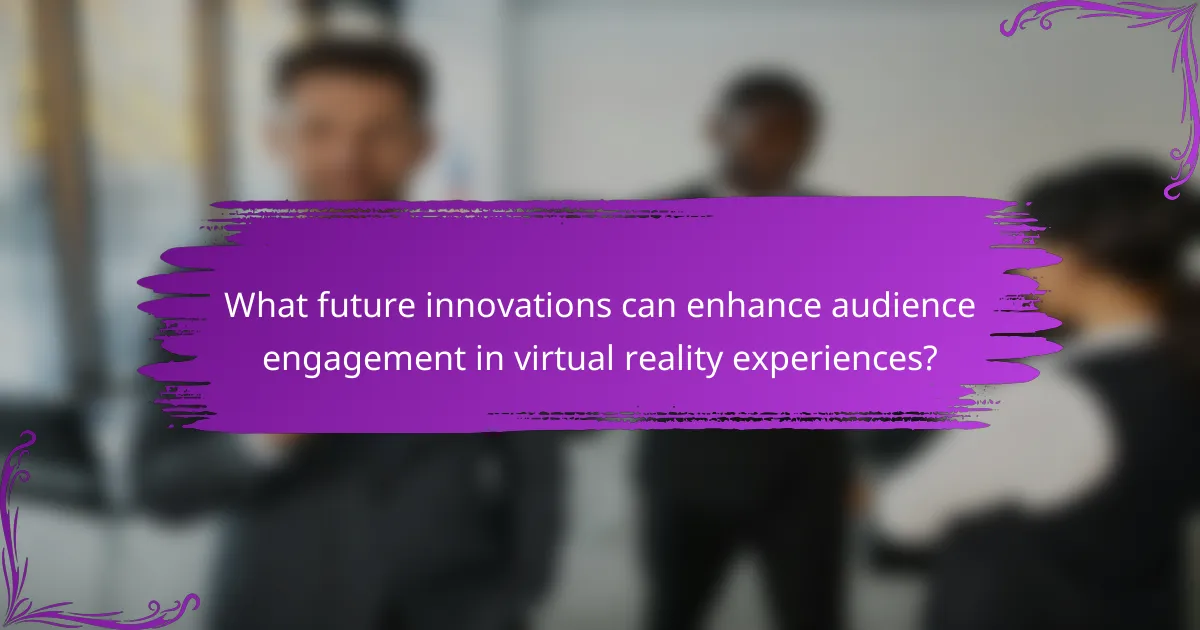
What future innovations can enhance audience engagement in virtual reality experiences?
Future innovations that can enhance audience engagement in virtual reality experiences include improved haptic feedback, AI-driven interactive narratives, and enhanced social interaction features. Improved haptic feedback allows users to feel sensations that mimic real-world interactions. This technology can create a deeper emotional connection to the virtual environment. AI-driven interactive narratives adapt to user choices, making each experience unique. This personalization increases user investment and enjoyment. Enhanced social interaction features enable users to engage with others in real-time. This fosters a sense of community and shared experiences. Collectively, these innovations aim to create immersive, engaging, and memorable virtual reality experiences.
How might emerging technologies change the landscape of audience engagement?
Emerging technologies will significantly transform audience engagement by enhancing interactivity and personalization. Virtual reality (VR) and augmented reality (AR) provide immersive experiences that captivate users. These technologies allow audiences to interact with content in real-time, fostering deeper connections. For instance, VR can simulate environments that users can explore, increasing emotional investment. Additionally, AI-driven analytics can tailor content to individual preferences, making experiences more relevant. A report by PwC indicates that immersive technologies could contribute $1.5 trillion to the global economy by 2030. This economic potential reflects the growing importance of audience engagement in the digital landscape.
What potential does 5G technology hold for virtual reality experiences?
5G technology has significant potential to enhance virtual reality experiences. It offers ultra-low latency, which reduces lag in real-time interactions. This is crucial for immersive environments where timing is essential. Additionally, 5G supports higher data transfer speeds. This enables richer graphics and more detailed environments. With increased bandwidth, users can experience high-resolution VR content without buffering. Furthermore, 5G’s ability to connect multiple devices simultaneously enhances multiplayer VR experiences. It allows for more seamless social interactions within virtual spaces. Overall, 5G technology can transform how users engage with virtual reality.
How can advancements in haptic feedback improve user interactions?
Advancements in haptic feedback can significantly enhance user interactions by providing realistic tactile sensations. This technology allows users to feel textures, vibrations, and forces, creating a more immersive experience. For instance, in virtual reality (VR), users can sense the weight of objects they manipulate. This feedback can improve spatial awareness and task performance in virtual environments. Research indicates that enhanced haptic feedback leads to increased user satisfaction and engagement levels. A study published in the journal “IEEE Transactions on Haptics” found that users reported a 30% increase in immersion when utilizing advanced haptic devices. These advancements enable more intuitive controls, making interactions feel more natural and responsive. Overall, enhanced haptic feedback fosters deeper emotional connections and engagement in virtual experiences.
What best practices should creators follow for effective audience engagement?
Creators should prioritize authenticity and relatability to engage their audience effectively. Authenticity fosters trust and connection. Relatable content resonates with audience experiences. Consistent interaction through comments and messages encourages community. Utilizing storytelling enhances emotional engagement. Visual elements should be high-quality and relevant. Data-driven insights can guide content strategy. Regularly analyzing audience feedback improves future engagement. These practices are supported by studies showing increased retention and satisfaction among engaged audiences.
How can storytelling techniques be adapted for virtual reality?
Storytelling techniques can be adapted for virtual reality by immersing users in interactive narratives. This allows users to influence the storyline through their choices. Spatial storytelling can enhance engagement by placing users in the story’s environment. Utilizing 360-degree visuals enables a more comprehensive experience of the narrative. Incorporating audio that responds to user movement can create a sense of presence. Non-linear story structures can provide users with multiple pathways and outcomes. Research shows that immersive storytelling increases emotional engagement and retention. The Journal of Virtual Worlds Research highlights that users in VR narratives report higher levels of empathy and connection.
What are the essential design principles for engaging virtual reality experiences?
The essential design principles for engaging virtual reality experiences include immersion, interactivity, and user-centric design. Immersion involves creating a believable environment that captures the user’s attention. This can be achieved through high-quality graphics and realistic sound. Interactivity allows users to influence the environment and outcomes, enhancing their engagement. User-centric design focuses on the needs and preferences of the audience. This ensures that experiences are intuitive and accessible. Research shows that experiences designed with these principles lead to higher user satisfaction and retention rates. A study by Freeman et al. (2017) found that immersive VR experiences significantly increased emotional engagement compared to traditional media.
What strategies can enhance audience retention in virtual reality experiences?
Engaging storytelling enhances audience retention in virtual reality experiences. Creating a compelling narrative keeps users invested in the experience. Interactive elements allow users to influence the story, increasing their emotional connection. Customization options enable users to tailor experiences to their preferences, fostering a sense of ownership. Regular updates and new content maintain interest over time. User feedback integration helps refine experiences based on audience preferences. Research shows that immersive environments increase user satisfaction and retention rates. A study by the University of Southern California found that participants in narrative-driven VR experiences reported higher engagement levels.
How can feedback loops be integrated into virtual reality experiences?
Feedback loops can be integrated into virtual reality experiences by using real-time user input to influence the virtual environment. This integration allows users to receive immediate responses to their actions. For instance, haptic feedback devices can simulate physical sensations when users interact with virtual objects. Additionally, adaptive AI can modify scenarios based on user decisions, enhancing engagement. Research shows that feedback loops improve learning outcomes in VR by reinforcing user actions. A study by Mikropoulos and Natsis (2011) found that interactive feedback significantly boosts user immersion and satisfaction in educational VR applications.
What role does community building play in sustaining audience interest?
Community building fosters ongoing engagement and loyalty among audiences. It creates a sense of belonging and encourages participation. Engaged audiences are more likely to return and interact with content. Research shows that 70% of consumers feel more connected to brands with strong communities. This connection enhances user experience and satisfaction. Active communities provide valuable feedback and insights, guiding content creation. They also facilitate networking and collaboration among members. Overall, community building is essential for maintaining audience interest in virtual reality experiences.
The main entity of the article is audience engagement in virtual reality (VR) experiences. The article explores how VR transforms audience engagement through immersive environments, interactivity, and emotional connections, leading to increased retention and user satisfaction. It outlines key elements that enhance engagement, such as immersion, social presence, and the role of emerging technologies like AI and 5G. Additionally, the article addresses challenges in achieving effective engagement and highlights current trends and future innovations that can further enhance user interactions in VR.
